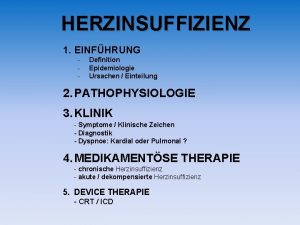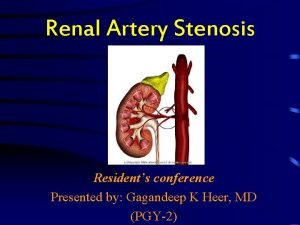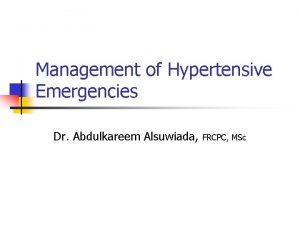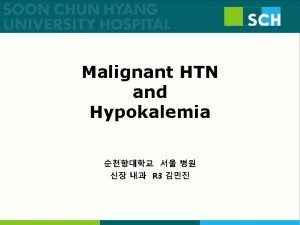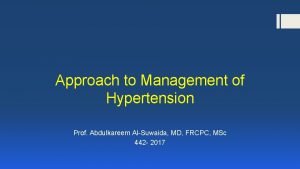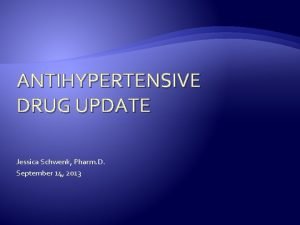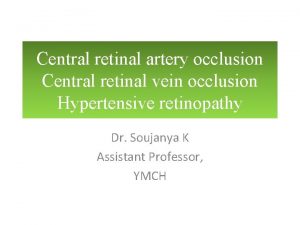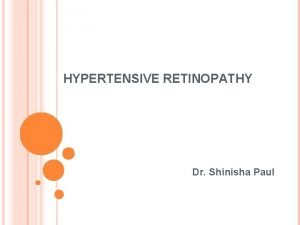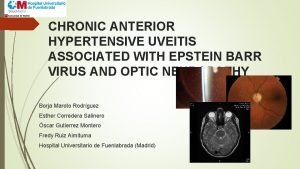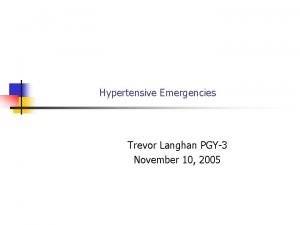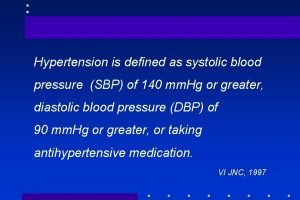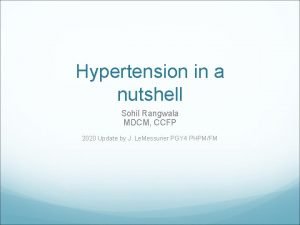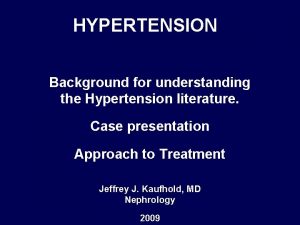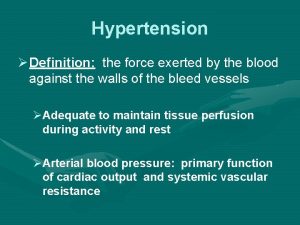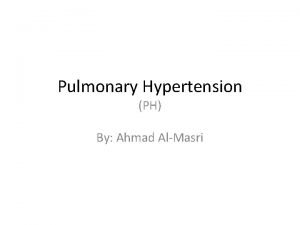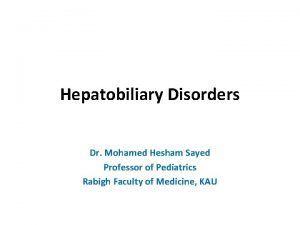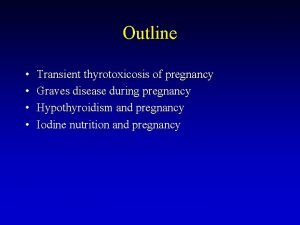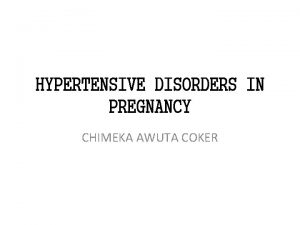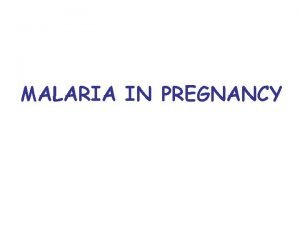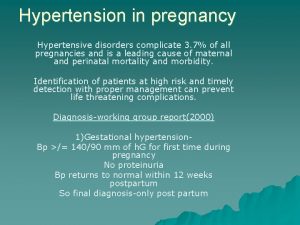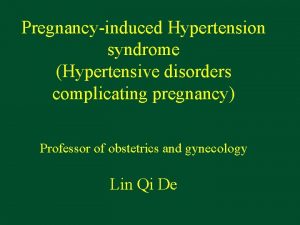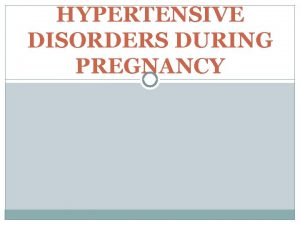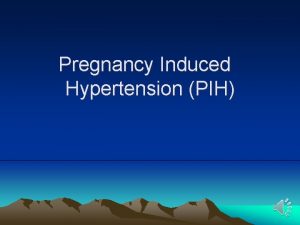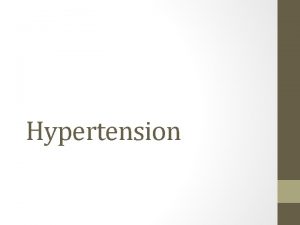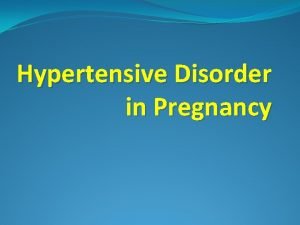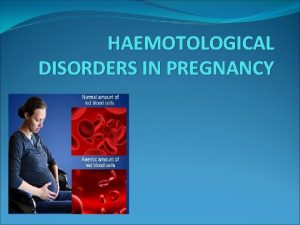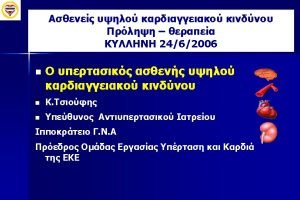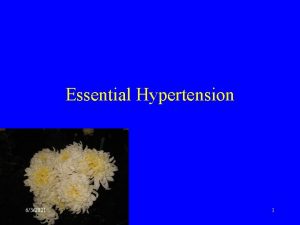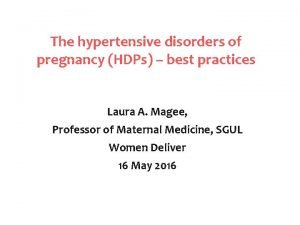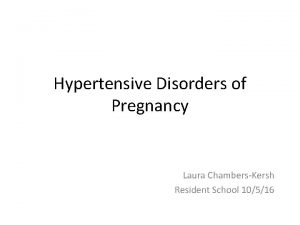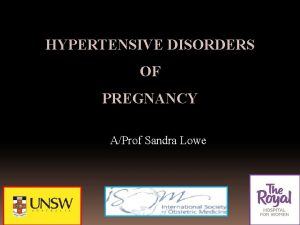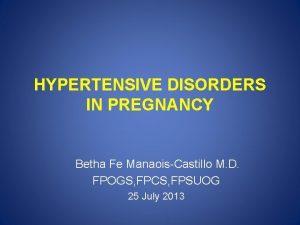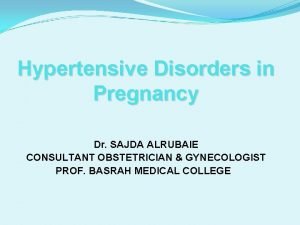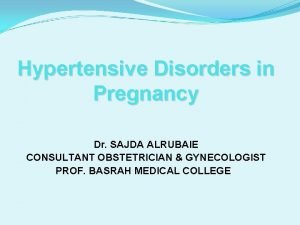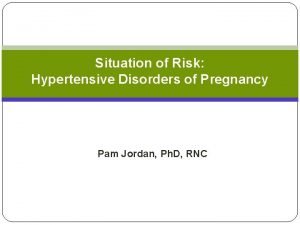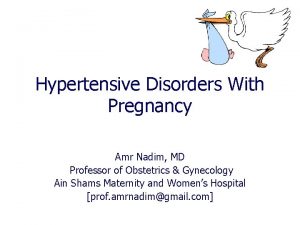HYPERTENSIVE DISORDERS OF PREGNANCY DEFINITION Hypertension is defined



























- Slides: 27

HYPERTENSIVE DISORDERS OF PREGNANCY

DEFINITION: � Hypertension is defined as changes of BP recorded on at least 2 occasions of either: Diastolic BP >90 mm. Hg, or Systolic BP >140 mm. Hg, or A rise (compared to booking) in diastolic BP of at least 15 mm. Hg, or A rise (compare to booking) in systolic BP of at least 30 mm. Hg.

CLASSIFICATION: Pregnancy-induced hypertension Chronic hypertension Pre-eclampsia: Eclampsia: Imminent eclampsia (fulminating preeclampsia)

PRE-ECLAMPSIA: q Incidence&Epidmiology: v It complicates approximately 3% of pregnancies. v It is more common in primigravida (effect of fetal and hence paternal genome). v Maternal genetic predispositions (3 -4 folds increase in the first-degree relatives of affected women).

RISK FACTORS FOR PREECLAMPSIA(PREDISPOSING FACTORS): 1. Conditions in which the placenta is large : - *multiple gestation. *diabetes. *hydrops. 2. Pre-existing hypertension or renal disease. 3. Pre-existing vascular disease (such as in diabetes or autoimmune vasculitis).

CLINICAL PRESENTATION: q May be asymptomatic. � Headache. � Visual disturbances. � Epigastric& right upper abdominal pain.

SIGNS OF PRE-ECLAMPSIA: � Elevation of BP. � Fluid retention (non-dependent oedema). � Brisk reflexes. � Ankle clonus (more than 3 beats). � Uterus & fetus may feel small for gestational age.

ETIOLOGY: � Trophoblastic tissue provides the stimulus for the disorder, so its only occurs in pregnancy , but it has been described in pregnancy lacking a fetus(molar pregnancy)& in the absence of the uterus ( abdominal pregnancy). � Trophoblastic invasion is patchy& the spiral arteries retain their muscular walls which interne prevent the development of a high flow, lowimpedance uteroplacental circulation, the reason for that is unknown.

ORGAN-SPECIFIC CHANGES ASSOCIATED WITH PRE-ECLAMPSIA � Central nervous system � Cerebral oedema. � Cerebral hemorrhages. � Retinal haemorrhage, exudates &papillodema are characteristic of hypertensive encephalopathy.

HEMATOLOGICAL � Platelet activation & depletion. � Coagulopathy. � Decreased plasma volume. � Increased blood viscosity.

Renal � Proteinuria � Decreased GFR(oliguria) � Decreased urate excretion (increase serum uric acid). q Hepatic � Periportal necrosis � Sub- capsular haematoma. � Elevation of liver enzymes. q

HELLP SYNDROME: � it is sever form of pre-eclampsia, occure in 2 -4% of women with pre-eclampsia & is associated with fetal loss rate of up to 60% if occur antenatally& a maternal mortality of up to 24%. � It may be associated with DIC&placental abruption. � H=Haemolysis. � EL=Elevated Liver enzymes. � LP=Low Platelet count.

DIAGNOSIS: � A diagnosis of pre-eclampsia usually requires admission of the patient for more intensive investigations & monitoring of her condition.

DIAGNOSIS: 1. ) Mild form: � BP mildly elevated i. e. diastolic BP of 90 -95 mm. Hg. � Minimal proteinuria. � Normal haematological&biochemical parameters. � Patient can be monitored as an outpatient, attending for regular fetal & maternal assessment. 2. ) Moderate (95 -105 mm. Hg), it requires admission to the hospital for investigation &follow up.

q 3. ) Sever pre-eclampsia is identified by symptoms of sever preeclampsia: - v Frontal headache Visual disturbance Epigastric pain General malaise & nausea Restlessness Signs of sever pre-eclampsia: v v q v v v Agitation Hyper- reflexia(clonus) Facial &peripheral odema Right upper quadrant tenderness Poor urine output

INVESTIGATION FOR PRE-ECLAMPSIA These investigations will be repeated at interval depending on the overall clinical picture. � Urinalysis by dipstick (quantitatively inaccurate). � 24 -hour urine collection for total protein &creatinine clearance). � Full blood count (platelets &haematocrit). � Blood chemistry (renal function , protein concentration ). � Plasma urate concentration. � Liver function. � Coagulation profile. � Ultrasound assessment Fetal size. Amniotic fluid volume. Doppler.

MATERNAL COMPLICATIONS q Increase maternal morbidity &mortality because of: Cerebral oedema, cerebral haemorrhage& retinal haemmorrhage. Heart failure & pulmonary oedema. Sub-capsular haematoma, periportal necrosis& elevated liver enzymes. Hematological complications: -Decrease platelets count, Haemolysis, Coagulopathy & DIC. Renal failure. HELLP syndrome. Increase risk of thrombosis (DVT, pulmonary embolism). Increase risk of APH & PPH. Increase risk of surgical interventions(c/s, instrumental delivery). Eclampsia. Adult Respiratory Distress Syndrome (ARDS

FETAL COMPLICATIONS: Increase perinatal morbidity & mortality. Preterm delivery (iatrogenic). IUGR. IUD. Birth asphyxia.

TREATMENT: v The mainstay of treatment is ending the pregnancy by delivering the fetus & placenta; this can be significant problem at 24 -32 weeks. v The aim of antihypertensive therapy is to lower the BP & reduce the risk of maternal cerebrovasular accident without reducing uterine blood flow & compromising the fetus.

ANTIHYPERTENSIVE DRUGS ARE: � � Methyldopa: centrally acting antihypertensive agent, safe, can only giving orally , need at least 24 hours to work, & it is the drug of choice antenatally. Labetolol: is an alpha & beta- blocking agent , it can be given orally or IV, safe , can be given antenatally&intrapartum to control BP in sever pre-eclampsia. Nifedipine : calcium-channel blocker with a rapid onset of action. It can, however , cause sever headache that mimic worsening disease. Hydralazine : arterial vasodilator , used IV in sever preeclampsia. So sever form of pre-eclampsia , IV infusion of hydralazine/labetolol can be titrated rapidly against changes in the BP.

MANAGEMENT OF ECLAMPSIA : � Maintain an open air way by mouth piece & oxygen. � maintain an 2 IV line & take blood samples for : i. Blood group &Rh. ii. CBC & Blood film. iii. LFT iv. RFT v. Serum uric acid. vi. Coagulation profile.

Control fit by giving magnesium sulphate which is given IV as bolus dose directly & maintenance dose over 24 hours after last fit. control BP by hydralizin / labetolol IV. Close observation of vital sign (PR, RR, BP, Temp. ), urine output , patellar reflex&clonus. Assessment of fetal condition & immediate delivery.

MAGNESIUM SULPHATE (MGSO 4) *Centrally acting anticonvulsant drug. * act as membrane stabilizing agent. * can be given iv or im but preferable iv * Is the drug of choice (1 st drug of choice) in the acute phase treatment of eclamptic fit. *4 -6 g given iv slowly over at least 10 min to arrest fit, then maintain on 1 g / hr iv in drip for at least 24 hr from the last fit.

*should be monitored carefully while giving it because of its toxicity by: 1. measuring its level in the blood 2. monitering the following a) respiratory rate. b) urine output. c) patellar reflexes (1 st sign to disappear in Mg. SO 4 toxicity). * antidote of Mg. SO 4 toxicity is calcium gluconate 10%, 10 ml over 10 min given iv.

CHRONIC HYPERTENSION : Essential hypertension is the underlying cause in 90% of cases. q Before a diagnosis of essential hypertension is made, other causes of chronic hypertension should be excluded which are : Renal disease: glomerulonephritis. Polycystic disease. Diabetic nephropathy. Renal artery stenosis. Collagen vascular disease : -SLE - scleroderma. Coarctation of the aorta. Endocrine causes: -phaeochromocytoma. - conn s syndrome.

� Irrespective of the underlying cause , the principal concern is that these women may develop superimposed pre-eclampsia(1/3).

TREATMENT: q q 1. mild(BP<150/100): no need for immediate treatment, however , the pregnancy should be monitored carefully to detect any rise in BP or features of preeclampsia or IUGR. 2. BP>150/100: antihypertensive medication is recommended which includes: Methyldopa Labetolol Nifedipine. Aim of treatment is to maintain the BP < 160 mm. Hg &100 -110 mm. Hg diastolic. It is reasonable to await spontaneous labour or attempt vaginal delivery by induction at 38 weeks
 Early pregnancy pictures of spotting during pregnancy
Early pregnancy pictures of spotting during pregnancy Meto zerok 25 mg nebenwirkungen
Meto zerok 25 mg nebenwirkungen Hypertensive emergency
Hypertensive emergency Well-defined objects
Well-defined objects Endorine
Endorine Malignant hypertension treatment
Malignant hypertension treatment Htn emergency vs urgency
Htn emergency vs urgency Htn emergency vs urgency
Htn emergency vs urgency Case scenario for hypertension
Case scenario for hypertension Keith and wegner hypertensive retinopathy
Keith and wegner hypertensive retinopathy Keith wagner barker
Keith wagner barker Hemmorragie
Hemmorragie Thyroid storm nursing interventions
Thyroid storm nursing interventions Hypertensive uveitis
Hypertensive uveitis The cardiovascular system chapter 11
The cardiovascular system chapter 11 Increase bp
Increase bp Hypertensive urgency vs emergency
Hypertensive urgency vs emergency Diagnosing hypertension
Diagnosing hypertension Malignant hypertension
Malignant hypertension Bp = co x svr
Bp = co x svr Definition of hypertension
Definition of hypertension Pulmonary hypertension severity
Pulmonary hypertension severity Essential hypertension
Essential hypertension Pulmonary hypertension definition
Pulmonary hypertension definition Ascites veins
Ascites veins Normal pregnancy definition
Normal pregnancy definition Normal pregnancy definition
Normal pregnancy definition Malaria in pregnancy definition
Malaria in pregnancy definition

